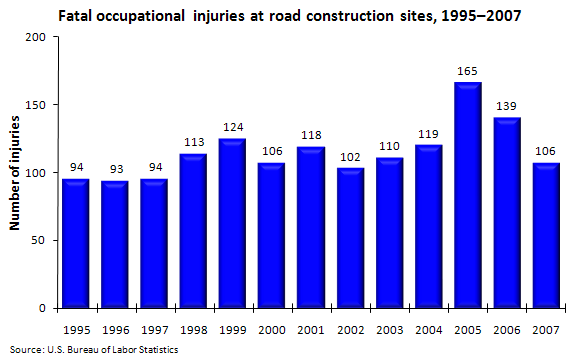December 08, 2010 (The Editor’s Desk is updated each business day.)
Fatal occupational injuries at road construction sites, 1995–2007
Although the total number of fatal occupational injuries (all industries) declined nearly 10 percent from 1995 to 2007, the number of fatal injuries at road construction sites increased over that period—both in number and as a percentage of all workplace fatalities.

[Chart data]
Over the 5-year period from 2003 to 2007, there were 639 fatal occupational injuries at road construction sites, which accounted for 2 percent of fatal occupational injuries overall. During these 5 years, the high occurred in 2005 (165 fatalities) and the low occurred in 2007 (106 fatalities).
Male workers accounted for more than 97 percent of the fatal work injuries at road construction sites during the 2003–07 period, compared with 93 percent for all fatal work injuries and 99 percent for fatal work injuries in the construction industry. Hispanic or Latino workers were slightly more likely to be killed at a road construction site than they were in all fatal workplace injuries.
Nearly 17 percent of the workers killed at road construction sites from 2003 to 2007 were born outside of the United States. Almost 80 percent of these foreign-born workers were Hispanic or Latino.
These data are from the Census of Fatal Occupational Injuries (CFOI), which is part of the BLS Injuries, Illnesses, and Fatalities program. CFOI compiles a count of all fatal work injuries occurring in the United States during a given calendar year. To learn more, see "Fatal occupational injuries at road construction sites, 2003–07" (PDF) in the November 2010 issue of the Monthly Labor Review.
Related TED articles
Industry studies |
Occupational safety and health |
Occupations
Of interest
Spotlight on Statistics: National Hispanic Heritage Month
In this Spotlight, we take a look at the Hispanic labor force—including labor force participation, employment and unemployment, educational attainment, geographic location, country of birth, earnings, consumer expenditures, time use, workplace injuries, and employment projections.
.
Read more »
